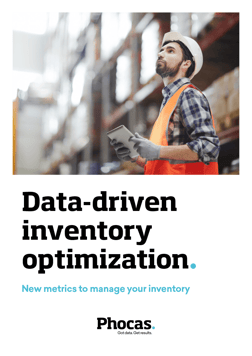Why you need business intelligence for inventory management

This is the time of year when we traditionally like to take stock of things. It’s the season when we look around and work out where we’ve got to and hopefully use that review to inform ourselves in the way forward.
But taking stock on the business front is also foremost for an organisation and its employees at around this time too. Physically taking stock of items such as products, components and raw materials can form part of that process; but so can looking at the whole area of Inventory as well.
Because inventory is a specialised function, it is often overlooked that in reality it involves the entire company. Sure, the Inventory Planner, Purchasing Manager and the warehouse staff usually have the organisation’s management of inventory well in hand. However, what about everyone else in the business who are also affected in so many ways by Inventory? Colleagues in the sales function for instance live or die by the availability and throughput of product. Here, the status of back orders and of forward ordering, are key factors behind sales success, which cannot be handled without clear visibility of Inventory in the Sales department.
Similarly, Marketing colleagues need to schedule the development, introduction and withdrawal of product ranges – something that is entirely dependent on forecasting based on an understanding of Inventory. And in an organisation where inter-company transfers are common, inventory issues can directly impact upon the costs of those transfers.
Traditionally, the management of inventory has revolved around the data from an organisation’s ERP/accounting software package which usually handles what is needed by specialised Inventory staff fairly adequately. But all of those other colleagues in different departments who are not specialists in Inventory, normally get little or no access to ad-hoc inventory capability despite their needs.
What they require is not Inventory Management but Inventory Visibility. And that is where Business Intelligence comes in. For some years, giant do-everything BI/Business Warehouse type of solutions (the ones with the giant price tags to match) have offered to cover this area in a general sense. But more recently, increasingly affordable, specialised manufacturing/distribution BI packages have been offering better targeted solutions to this issue.
For the non-specialist key staff in those other departments of the company, a good BI tool can offer such Inventory analyses as:-
- Dead stock analysis (including forward orders for products which have sold little in recent months)
- Purchase orders and purchase receipts – to identify what’s arrived in the warehouse.
- Brought-forward value – current stock taken forward.
- Identification of likely shortages.
- Information to deal with situations where particularly long lead-times exist. This is especially important where “just in time” or “On Time In Full” (OTIF) requirements exist!
- Inter-company movement stock analysis.
- Inventory point-in-time levels (e.g. capturing inventory levels at the start/end of each period, such as monthly, to build up an inventory trend picture)
- Sales orders, invoices, back orders and forward orders in any combination, sliced & diced to your requirements.
This clearly taps into the understanding that an organisation will create strong progress by utilising company-wide data visibility (such as that delivered by a quality Business Intelligence solution) to latch onto potential areas of business growth: Inventory is just one such area!
Phocas Software's business intelligence offering is used by numerous companies around the world to successfully manage their inventory. Watch a demo of Phocas in action to see how it can help your business.

Empowering businesses with intuitive data analytics, driving informed decisions for growth and profitability. We make people feel good about data.

Using data to plan for the impact of tariffs and further change
Tariffs are here. Whether you're in manufacturing, distribution or retail, it's important to understand how importing from affected countries such as Canada, Mexico or China or chosing local production, can affect your bottom line. We want to encourage you to scenario plan now not retrospectively.
Read more
Demand planning and forecasting
For finance teams in manufacturing, distribution or retail, effective demand planning is critical to meeting customer expectations without tying up cash in excess inventory. When done right, it ensures the right products are available at the right time and in the right quantities.
Read more
The value of integrating financial and operational data
In today’s fast-paced business world, operational efficiency and confident decision-making are key to keeping your competitive edge. However, leveraging financial and operational data to do just that is a significant challenge for many organizations.
Read more
What is sales and operations planning (S&OP)
Sales and operational planning (S&OP) helps businesses to align their strategic goals with day-to-day operations. By integrating financial planning with operational and sales planning, S&OP ensures that all departments work cohesively towards common objectives. This process operates on strategic and tactical levels, providing insights that influence long-term decisions while guiding day-to-day actions. Understanding the dual focus of S&OP is essential for creating a robust plan that addresses immediate needs while positioning the company for future success.
Read more
Find out how our platform gives you the visibility you need to get more done.
Get your demo today